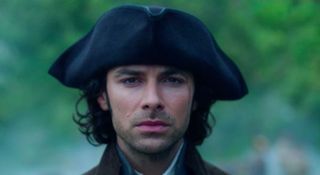The CG secrets of Poldark revealed
Downton Abbey veterans Lexhag explain how they met the VFX challenges of hit BBC show Poldark.
Getting client sign-off
Before Lexhag had to sell the audience on the believability of the ship, however, they needed to sell it to the client – a buy-off process that can often be more challenging than the creation of the ship itself. "Sign-off procedure is rarely straightforward – it's getting the buy-in from the client that takes time and effort," says Marbrook.
"Thankfully, tracking tools like ftrack come in really handy with that. It allows you to have individual elements of the boat in either a signed-off state or a not-completed state. Signed off means that the client is happy. Not completed means there are more notes to address – and getting that right is really important for a production.

"Say, for example, you get to the compositing stage and the client mentions there's something wrong with the animation or modelling – that can take a really long time to unpick what you've done. So, you need to make sure you have sign-off confirmed for those elements ahead of time, and ftrack is a great guide for that: it enables us to say 'this milestone is complete' and refer back to an email from the client at a specific time confirming that sign-off.
"Managing client expectations is a huge part of the visual effects process, and ftrack is well on the way to giving you the tools to be able to overcome those problems."
Production management
Lexhag first adopted ftrack in September 2014, using it on the first block of Poldark but also on other shows that came through at the same time, such as BBC drama The C Word.
"At the time of writing, we've been using ftrack for about 18 months to a year," explains Marbrook. "We started using it on a Scottish film project called Swung, and then for a movie called Chosen.
"We had used other production tools in the past, but we found the artists weren't using or updating the projects in quite the right way. Also they felt like glitzy Excel spreadsheets, and could be easily broken. ftrack looks a lot nicer and works more towards the way that we tend to do things.
Get the Creative Bloq Newsletter
Daily design news, reviews, how-tos and more, as picked by the editors.

"It's really simple and straightforward, which is really helpful in an episodic production like Poldark," he continues. It's intuitive for a reason – you want every artist to be able to just look at what they've got to do that day very easily, which keeps the production running smoothly.
"We don't have to train the tool – the artists can just can sign in, see what they need to do that day, and then move along each task until they've completed them. You don't really want artists doing anything other than that; you just want them focusing on the job they're doing and the creative side of the production."
Staying on schedule
On Poldark specifically, ftrack offered great assistance in keeping the production on schedule – something that is absolutely imperative when working with complex assets such as on-set LIDAR scans and full-CG models.
"ftrack really helped with breaking up the tasks into subsets and letting each artist just focus on the task in hand," says Dulull. "Time logging allows us to track the project's main resources, but also there's the man spreadsheet with the task status, which comes in very useful when using it in conjunction with filters. It makes it very easy to send status reports to our clients and post supervisors on a daily basis.
"Also, it's just such a great time- and money-saving tool," he continues. "It definitely minimised emails, which we are not a fan of since you always end up losing comments and feedback stored in email threads. Also, we can instantly tell when a shot is about to go over budget – this would flag up to us in advance to ensure we don't end up digging into our own funds to make up for overages."
Thanks to the simple and straightforward nature of ftrack, Lexhag was able to keep the complexity of Poldark in check. "ftrack is definitely a good start," says Marbrook. "I know other tools require a team of people to manage them – why do you need a team of managers to manage a management tool? It tells you that something is amiss there.
"With ftrack that's not necessary. It's got a lot of potential, and has helped us simply manage a lot of big projects. We've won future business of the back of Poldark, so will definitely be using it again."
3D World's TV special on sale now!

For more about creating visual effects for television, don't miss the latest issue of 3D World magazine.
On sale now, issue 199 features a 12-page feature on the rise of TV VFX, an in-depth article about hit drama Continuum, a Game of Thrones-themed tutorial, and much more. You can find out more about what's in the issue here.
Like this? Read these
- The 12 best animations of the past 20 years
- Free Photoshop brushes every creative must have
- Hands-on review: Adobe After Effects CC

Thank you for reading 5 articles this month* Join now for unlimited access
Enjoy your first month for just £1 / $1 / €1
*Read 5 free articles per month without a subscription

Join now for unlimited access
Try first month for just £1 / $1 / €1
The Creative Bloq team is made up of a group of design fans, and has changed and evolved since Creative Bloq began back in 2012. The current website team consists of eight full-time members of staff: Editor Georgia Coggan, Deputy Editor Rosie Hilder, Ecommerce Editor Beren Neale, Senior News Editor Daniel Piper, Editor, Digital Art and 3D Ian Dean, Tech Reviews Editor Erlingur Einarsson, Ecommerce Writer Beth Nicholls and Staff Writer Natalie Fear, as well as a roster of freelancers from around the world. The ImagineFX magazine team also pitch in, ensuring that content from leading digital art publication ImagineFX is represented on Creative Bloq.
